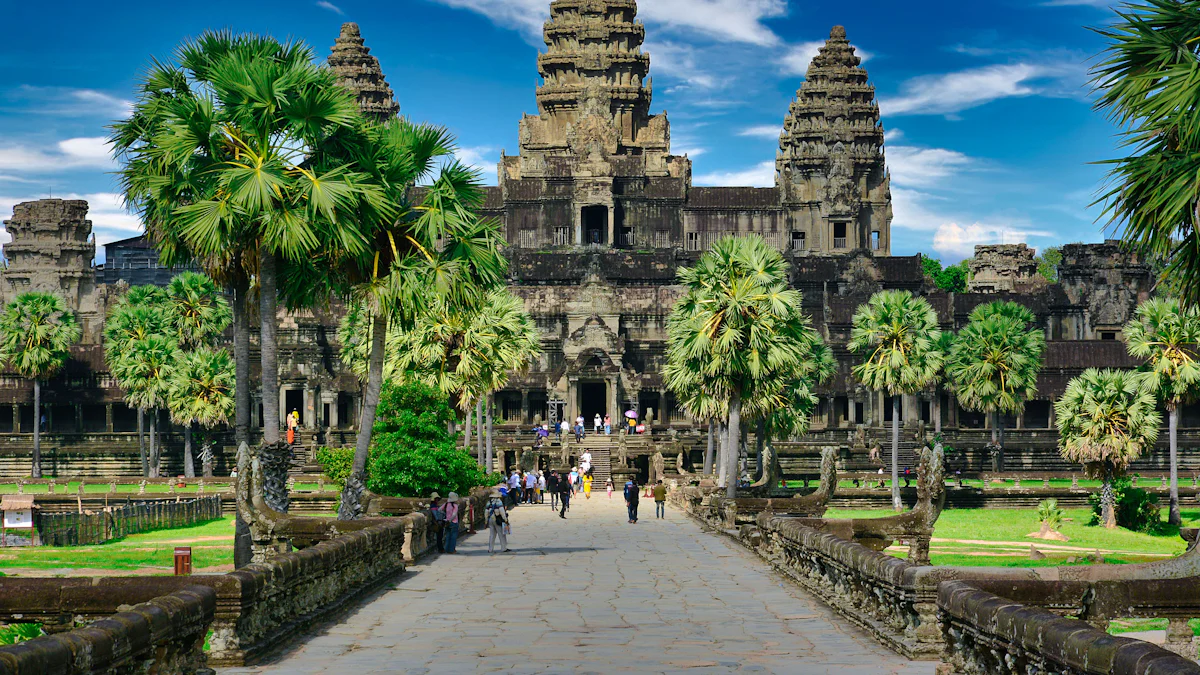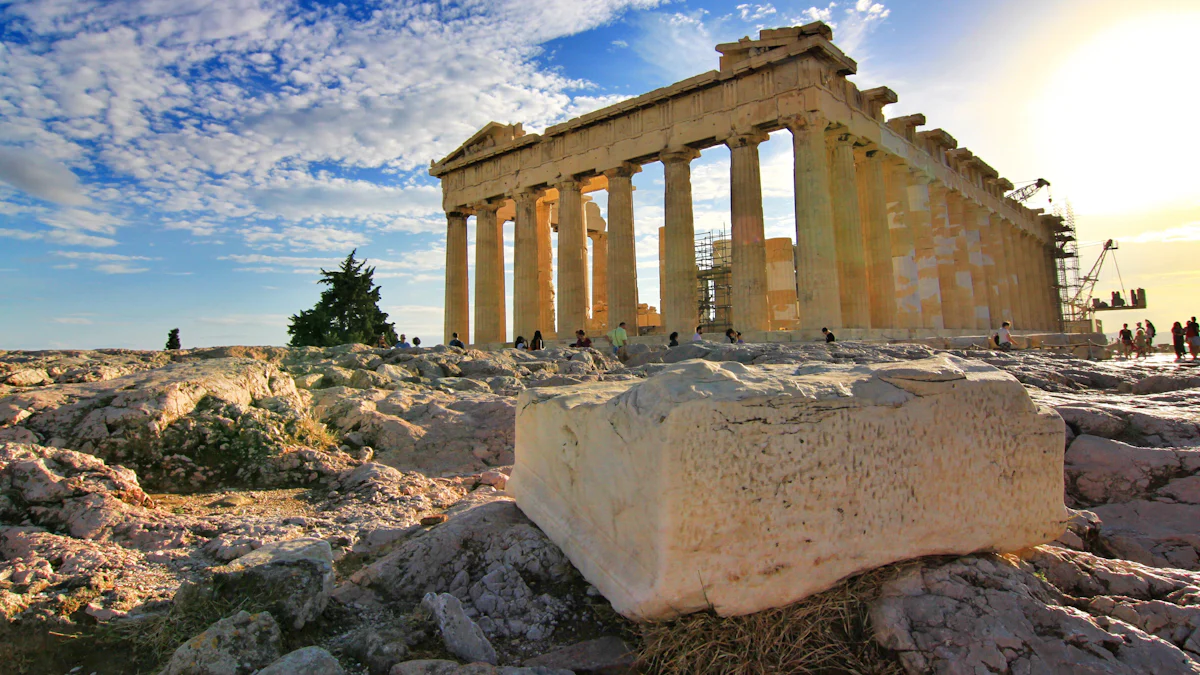Man-Made Wonders of the World

Human creativity and determination have given rise to some of the most awe-inspiring wonders on Earth. These man-made buildings and monuments captivate millions of visitors each year. The Colosseum in Rome, for example, attracts close to seven million tourists annually. Each wonder tells a unique story, reflecting the cultural diversity and historical significance of its time. From ancient monuments to modern buildings, these marvels showcase the incredible achievements of human ingenuity. Exploring these wonders offers a glimpse into the diverse cultures and traditions that have shaped our world.
Wonders of Asia

The Great Wall of China
Historical Background
The Great Wall of China stands as one of the most iconic wonders in the world. Construction began during the 7th century BC. Various dynasties extended and fortified the wall over centuries. The primary purpose involved protecting China from invasions by nomadic tribes. The wall stretches over 13,000 miles across northern China. This monumental structure symbolizes the strength and perseverance of ancient Chinese civilization.
Architectural Features
The Great Wall showcases remarkable architectural ingenuity. Builders used materials like stone, brick, tamped earth, and wood. The wall features watchtowers, battlements, and fortresses at regular intervals. These elements provided strategic defense points. The wall's design adapted to the diverse terrain, including mountains and deserts. The construction represents one of the largest building projects ever undertaken.
Cultural Significance
The Great Wall holds immense cultural significance for China. It attracts millions of tourists annually, making it a cultural superstar. The wall represents a symbol of national pride and unity. In 1987, UNESCO designated the Great Wall a World Heritage site. This recognition highlights its historical and cultural importance on a global scale.
Taj Mahal, India
Historical Background
The Taj Mahal, located in Agra, India, stands as a testament to love and beauty. Mughal Emperor Shah Jahan commissioned the mausoleum in memory of his favorite wife, Mumtaz Mahal. Construction began in 1632 and took over two decades to complete. The Taj Mahal reflects the rich history and heritage of the Mughal Empire.
Architectural Features
The Taj Mahal is renowned for its stunning architectural features. The structure consists of white marble, which gives it a luminous quality. A large dome crowns the central building, surrounded by four minarets. The complex includes a beautiful garden with a reflective pool. The intricate carvings and inlaid gemstones enhance the monument's elegance.
Cultural Significance
The Taj Mahal holds profound cultural significance in India and beyond. It symbolizes eternal love and devotion. The monument attracts millions of visitors each year, contributing to India's tourism industry. The Taj Mahal became a UNESCO World Heritage site in 1983. This designation underscores its importance as a masterpiece of world architecture.
Wonders of Europe

The Colosseum, Italy
Historical Background
The Colosseum stands as a testament to ancient Rome's architectural and engineering prowess. Construction began under Emperor Vespasian in AD 72 and completed by his successor, Titus, in AD 80. The Colosseum hosted grand spectacles, including gladiator games and animal hunts. These events entertained Roman citizens and showcased the empire's power. The opening ceremonies lasted 100 days, featuring thousands of animals and gladiators.
Architectural Features
The Colosseum's architecture reflects the brilliance of Roman engineering. The amphitheater could hold up to 50,000 spectators. The elliptical structure measures 620 feet in length and 513 feet in width. Arches and columns support the massive stone and concrete building. The design includes a complex system of vaults and corridors. This allowed efficient movement of crowds and quick scene changes during events.
Cultural Significance
The Colosseum remains a major source of tourism revenue for Italy. Millions of visitors explore this iconic monument each year. The structure symbolizes the grandeur and might of ancient Rome. The Colosseum ranks as the second most visited monument in the world. Its preservation highlights the importance of cultural heritage and history.
Eiffel Tower, France
Historical Background
The Eiffel Tower represents a marvel of modern engineering. Gustave Eiffel's company designed and built the tower for the 1889 World Fair. The structure commemorated the centennial of the French Revolution. The Eiffel Tower initially faced criticism from artists and intellectuals. Over time, it became a beloved symbol of Paris and innovation.
Architectural Features
The Eiffel Tower stands at an impressive height of 1,083 feet. The iron lattice structure consists of over 18,000 metallic parts. Rivets connect these parts, forming a sturdy yet elegant design. The tower features three levels accessible to the public. Visitors enjoy panoramic views of Paris from observation decks. The tower's design showcases the potential of iron as a building material.
Cultural Significance
The Eiffel Tower attracts millions of tourists annually. The monument serves as a global icon of France and its culture. The tower's presence enhances the Parisian skyline and identity. The Eiffel Tower represents human ingenuity and artistic expression. Its enduring popularity underscores the value of architectural wonders.
Wonders of the Americas
Machu Picchu, Peru
Historical Background
Machu Picchu stands as a testament to the ingenuity of the Inca civilization. Construction began in the mid-15th century under Emperor Pachacuti. The site served as a royal estate and religious retreat. The Spanish conquest left Machu Picchu largely unknown to the outside world. Rediscovery occurred in 1911 by Hiram Bingham, an American historian.
Architectural Features
Machu Picchu showcases remarkable stone construction. Builders used dry-stone walls that fit together without mortar. The site includes terraces, temples, and plazas. The Intihuatana stone functions as an astronomical clock. The location on a mountain ridge offers breathtaking views of the Andes. The architecture harmonizes with the natural landscape.
Cultural Significance
Machu Picchu holds immense cultural value for Peru. The site symbolizes the achievements of the Inca Empire. UNESCO designated Machu Picchu a World Heritage site in 1983. The monument attracts millions of tourists each year. Preservation efforts aim to protect this wonder for future generations.
Statue of Liberty, USA
Historical Background
The Statue of Liberty symbolizes freedom and democracy. France gifted the statue to the United States. Inauguration took place in 1886 on Liberty Island. The statue commemorates the centennial of American independence. Frédéric Auguste Bartholdi designed the statue. Gustave Eiffel engineered the internal structure.
Architectural Features
The Statue of Liberty stands at a height of 305 feet. Copper sheets form the outer layer, giving a green patina. The torch represents enlightenment. The crown features seven rays symbolizing the seven continents. A broken chain lies at the statue's feet, representing freedom. Visitors can access observation decks inside the statue.
Cultural Significance
The Statue of Liberty serves as an icon of the American dream. Millions visit the monument annually. The statue welcomes immigrants arriving by sea. UNESCO recognized the statue as a World Heritage site in 1984. The monument remains a powerful symbol of hope and opportunity.
Wonders of Africa
The Pyramids of Giza, Egypt
Historical Background
The Pyramids of Giza stand as monumental achievements of ancient Egyptian civilization. Construction began during the Fourth Dynasty around 2580 BC. Pharaohs commissioned these structures as grand tombs. The pyramids served as burial sites for rulers like Khufu, Khafre, and Menkaure. These wonders reflect the Egyptians' belief in the afterlife.
Architectural Features
The Pyramids of Giza showcase extraordinary architectural precision. Builders used massive limestone blocks. Each pyramid aligns with the cardinal points of the compass. The Great Pyramid of Khufu originally stood at 481 feet. Workers transported stones from distant quarries. The construction methods remain a subject of fascination and study.
Cultural Significance
The Pyramids of Giza hold immense cultural importance. These structures symbolize the power and religious beliefs of ancient Egypt. Millions of visitors explore these wonders each year. The pyramids represent human ingenuity and ambition. UNESCO recognized the site as a World Heritage Site in 1979. Preservation efforts continue to protect this iconic heritage.
Great Mosque of Djenné, Mali
Historical Background
The Great Mosque of Djenné stands as a testament to the architectural brilliance of West Africa. The original mosque dates back to the 13th century. French colonial rulers rebuilt the mosque in 1906–07. The mosque became a UNESCO World Heritage Site in 1988. This recognition highlights its historical and cultural value.
Architectural Features
The Great Mosque of Djenné is the largest mud-brick building in the world. Builders used sun-baked earth bricks and a plaster coating. Wooden beams protrude from the walls for support. The mosque features three minarets and a central courtyard. The design reflects traditional Sudano-Sahelian architecture.
Cultural Significance
The Great Mosque of Djenné remains a vital part of Mali's cultural identity. The mosque serves as a center for Islamic worship and community gatherings. Annual maintenance involves a community festival. This event reinforces cultural traditions and unity. The mosque attracts scholars and tourists interested in African architecture.
Wonders of Oceania
Sydney Opera House, Australia
Historical Background
The Sydney Opera House stands as a marvel of modern architecture. Construction began in 1959 and concluded in 1973. The building tested the limits of engineering, construction, and design. Jørn Utzon, a Danish architect, designed the structure. An architectural design competition attracted 233 entries from architects worldwide. The government of New South Wales funded the project. The opera house quickly became an iconic symbol of Australia.
Architectural Features
The Sydney Opera House features a series of large, shell-like structures. These shells form the roof of the building. The design resembles sails on the harbor. The building includes multiple performance venues. These venues host concerts, operas, and theater productions. The exterior consists of white tiles that reflect sunlight. The interior showcases wood paneling and plush seating. The design harmonizes with the surrounding water and skyline.
Cultural Significance
The Sydney Opera House holds immense cultural value. The building attracts millions of visitors each year. The opera house serves as a hub for the performing arts. Artists from around the world perform at this venue. UNESCO recognized the opera house as a World Heritage-listed masterpiece. This recognition highlights its global significance. The structure embodies human creativity and innovation. The opera house remains a testament to the wonders of modern architecture.
Human ingenuity and cultural diversity shine through these man-made wonders. Each structure reflects a unique blend of creativity and tradition. The achievements inspire awe and admiration. Exploring these marvels offers insights into different cultures and histories. A deeper understanding of these wonders encourages appreciation and respect for global heritage. Embrace the opportunity to learn more about these incredible feats of human endeavor.
See Also
Exploring the World's Masterpiece Maps: Unveiled and Described
Charting the USA: Cartography and Prints that Formed the Nation
Builders: Ancient Pyramids to Modern Space Explorers

